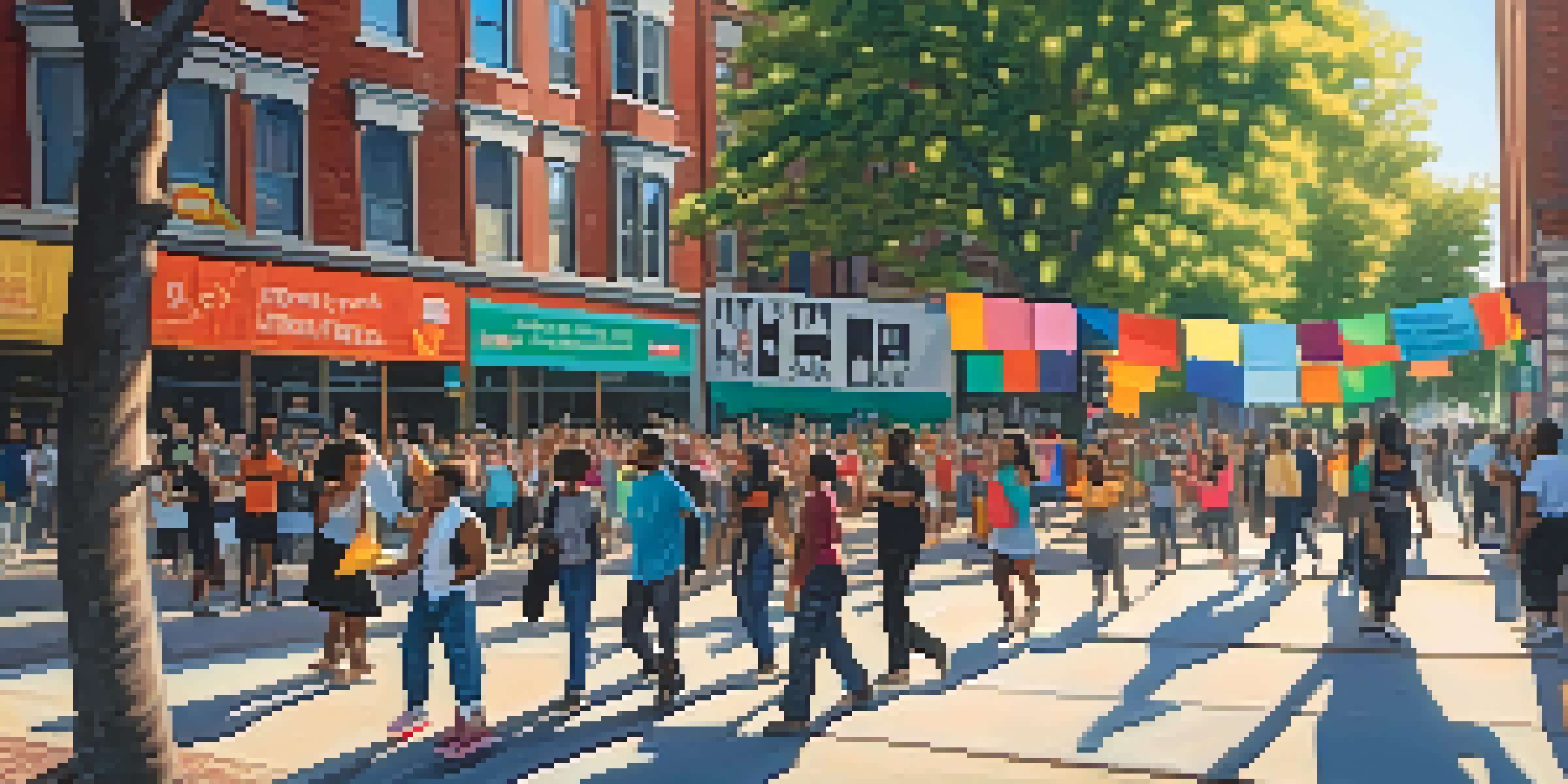Historical Overview of Community Activism in Major Cities

The Roots of Community Activism in Urban Centers
Community activism has deep roots in urban areas, often emerging as a response to social injustices. In the late 19th and early 20th centuries, industrialization led to rapid urban growth, bringing together diverse populations with shared challenges. This environment fostered a sense of collective identity, enabling communities to rally for change, from labor rights to housing reforms.
Injustice anywhere is a threat to justice everywhere.
As cities expanded, grassroots movements began to take shape, with activists organizing to address pressing issues like poverty and discrimination. These early efforts were often met with resistance, but they laid the groundwork for future advocacy and community-building initiatives. Organizations like the NAACP and the Labor Movement highlighted the power of collective action in fighting systemic inequalities.
Thus, the roots of community activism can be traced back to a time when urban centers were battlegrounds for rights and reforms. The struggles faced by these early activists continue to inspire modern movements, showcasing the enduring spirit of community-led change.
The Civil Rights Movement: A Turning Point
The Civil Rights Movement of the 1950s and 1960s marked a significant turning point for community activism in major cities across the United States. This era saw individuals and groups unite to demand equal rights and challenge racial discrimination, particularly in the South. Urban centers like Birmingham and Atlanta became focal points for protests, sit-ins, and marches that captured national attention.

The movement not only highlighted the struggles faced by African Americans but also demonstrated the effectiveness of organized, nonviolent resistance. Figures like Martin Luther King Jr. emerged as pivotal leaders, inspiring countless others to join the fight for justice. The success of the Civil Rights Movement set a precedent for future activism, proving that collective voices could enact meaningful change.
Historical Roots of Activism
Community activism has deep historical roots in urban centers, emerging as a response to social injustices and collective challenges.
Moreover, the lessons learned during this time resonate today, reminding us that community activism is crucial in addressing ongoing social issues. The legacy of the Civil Rights Movement continues to empower new generations of activists, emphasizing the importance of standing together for a common cause.
The Rise of Environmental Activism
In the late 20th century, a new wave of activism emerged, focusing on environmental issues that affected urban communities. As industrialization continued to impact air and water quality, residents in major cities began to advocate for cleaner environments and sustainable practices. Grassroots organizations sprang up, highlighting the need for policy changes to protect both public health and natural resources.
The power of the people is greater than the people in power.
Cities like San Francisco and New York became leaders in environmental activism, with movements pushing for recycling programs, green spaces, and pollution control. The establishment of Earth Day in 1970 further galvanized public awareness and participation in ecological issues. Community members recognized that environmental justice was intertwined with social justice, as marginalized populations often faced the brunt of environmental hazards.
Today, the legacy of this environmental activism is evident in various urban initiatives aimed at sustainability. From community gardens to climate action plans, cities continue to evolve through the lens of environmental responsibility, showcasing the power of community-driven change.
Grassroots Movements in the 21st Century
The 21st century has witnessed a resurgence of grassroots movements in major cities, fueled by technology and social media. Platforms like Twitter and Facebook have enabled activists to connect, organize, and amplify their messages more broadly than ever before. This digital landscape has transformed the way communities mobilize around issues such as racial inequality, police brutality, and climate change.
Prominent movements such as Black Lives Matter and the Women’s March have exemplified the power of online organizing, drawing millions into the streets to advocate for social justice. These movements have not only raised awareness but have also prompted policy discussions at local, state, and national levels. The ability to share stories and experiences through social media has fostered a sense of solidarity among diverse groups.
Technology Transforms Activism
The rise of technology and social media has revolutionized community activism, enabling broader organization and mobilization for social justice.
As we navigate this new era of activism, the importance of community engagement remains paramount. The interplay between digital activism and on-the-ground efforts continues to shape the landscape of social change, proving that when communities unite, they can create a powerful force for good.
Impact of Gentrification on Community Activism
Gentrification has emerged as a critical issue in many major cities, significantly impacting community activism. As neighborhoods undergo transformation, long-time residents often find themselves displaced due to rising rents and changing demographics. This has sparked a new wave of activism focused on preserving affordable housing and protecting the rights of existing residents.
Cities like San Francisco and Brooklyn have become battlegrounds where activists fight to maintain their communities' identities. Through organizing, protests, and policy advocacy, residents are challenging the status quo and demanding equitable development. This fight is not just about housing; it's about ensuring that communities retain their voices amidst rapid change.
Ultimately, gentrification highlights the need for a balanced approach to urban development. Community activists are working tirelessly to ensure that the benefits of revitalization are shared equitably, reminding us that every neighborhood's history and culture deserve respect and protection.
The Role of Technology in Modern Activism
Technology has revolutionized the landscape of community activism, providing new tools for organizing and advocacy. From online petitions to live-streaming protests, activists can now share their messages and mobilize supporters with unprecedented speed. This has democratized activism, allowing voices that were once marginalized to gain visibility and influence.
Moreover, technology facilitates collaboration among various organizations and communities, breaking down barriers that may have previously hindered collective action. For instance, apps and platforms dedicated to social justice allow for real-time updates and coordination during events, enhancing the effectiveness of grassroots efforts. The ability to reach a global audience means that local issues can resonate on an international scale.
Future Focus on Intersectionality
Future community activism will emphasize intersectionality, tackling interconnected issues like climate change, racial justice, and economic inequality.
However, with these advancements come challenges, such as misinformation and digital surveillance. Activists must navigate these obstacles while maximizing the positive impacts of technology. As we look to the future, the marriage of activism and technology will continue to evolve, shaping how communities fight for their rights.
Looking Ahead: The Future of Community Activism
As we reflect on the historical overview of community activism in major cities, it's essential to consider what lies ahead. The challenges facing urban communities are complex and multifaceted, requiring innovative approaches and sustained collaboration. Future activism will likely focus on intersectionality, recognizing that issues like climate change, racial justice, and economic inequality are deeply interconnected.
Emerging leaders and younger generations are bringing fresh perspectives and strategies to the table, utilizing both traditional organizing methods and modern technology. This blend of old and new approaches creates a dynamic environment for activism, fostering resilience and adaptability. Communities will continue to innovate, finding creative solutions to address their unique challenges.

Ultimately, the future of community activism hinges on collective action and solidarity. By learning from the past and embracing new tools and ideas, communities can work together to forge a more just and equitable future for all.